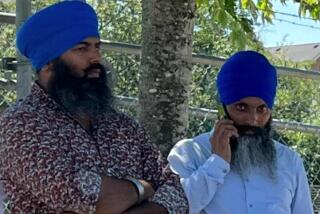Ethnic Discord : Sikhs Restore Shrine, Militancy : Ritual daggers are traded for fine-tipped paintbrushes as artisans perch on rickety scaffolds working on the Throne of the Almighty.
- Share via
AMRITSAR, India — In the dimly lit interior of a shrine sacred to the world’s 18 million Sikhs, a trio of men wearing tightly bound turbans sit on a rickety wooden scaffold, their faces grazing the ornately sculpted ceiling.
The rites of the faith require every Sikh male, all of whom ritually take the name “Singh,” or lion, to carry a dagger. But these men helping restore the building called the Akal Takht, or Throne of the Almighty, wield only fine-tipped paintbrushes.
With gentle delicacy and a precision worthy of an illustrated text on botany, they are turning the chamber’s ceiling into a richly hued garden of flowers. It will take no less than year to finish the job in the room that measures only 10 feet by 10 feet.
A decade ago, on June 5-6, 1984, the place where these artisans are now quietly at work was a furious battleground as Indian army commandos and tanks assaulted the holiest shrine in Sikhdom, the Golden Temple, in this city 15 miles from the Pakistani border.
At least 500 Sikhs and 83 Indian soldiers were killed as the army pounded and overran the fortified complex defended by fundamentalist leader Jarnail Singh Bhindranwale and his heavily armed followers.
Their headquarters was the golden-domed Akal Takht, symbol and seat of Sikhism’s temporal power and home to swords and other relics that belonged to its gurus. From the building’s basement, when his followers were slain or subdued, Indian soldiers carried out the dead Bhindranwale’s body.
*
For believers of what is often called the youngest of the world’s great religions, the Indian army’s assault, code-named “Operation Blue Star,” was a heinous example of defilement.
A decade has now gone by, and most of the shell holes, bullet marks, broken marble and other wreckage left by the firefight have been repaired. Today, the Golden Temple complex, which its leaders claim suffered more than $300 million in damage, is 90% restored, said Gurbachan Singh, the assistant information officer at the site.
In the rebuilding of the religious center at Amritsar, whose gleaming shrine stands in a pool of greenish-brown water (called amrit , or nectar, and believed to have healing properties), it is tempting to see an analogy in marble and gold leaf for the reconciliation of Sikhs with India’s authorities.
Reality, though, is more complex. Removing his shoes to enter the Golden Temple, the barefoot visitor may ascend to the Central Sikh Museum, on the second floor by the northern gate. There, a visual cram course awaits in the events that form the Sikh consciousness.
Room after room of oil paintings graphically show how, over the centuries, those who followed the preachings of the 10 Sikh gurus, or teachers, were broken on the wheel, scalped, beheaded, burned with kerosene or on a griddle, boiled, crushed by trains and hanged or shot by the British army and Indian police.
For the typical Indian, Blue Star remains an operation in which armed force was used to suppress a small band of Sikhs using the Golden Temple as a base from which to commit murder, torture and extortion and defy the government.
In the eyes of many Sikhs, however, it was an outrage and modern update of a time-worn, tragic theme: the victimization of Sikhs by the majority.
“Under the calculated move of Prime Minister of India Indira Gandhi, military troops stormed the Golden Temple with tanks,” reads a notice under the Central Sikh Museum’s lurid picture of the gutted, shell-pitted Akal Takht. “The Sikhs, however, soon had their vengeance.”
Beant Singh and Satwant Singh, the assassins of Mrs. Gandhi, still have places of honor in the museum’s portrait gallery. The Sikh bodyguards who, on Oct. 31, 1984, gunned down the woman they were supposed to protect are remembered not as murderers, but avengers.
A ruthless government campaign against militant Sikh separatism, which appears to be all but eradicated, has also kept suspicions and rancor smoldering.
“The Sikhs have started to feel that their traditions, the Sikh culture and way of life are in danger,” asserted Manjit Singh, 42, a thin, bespectacled professor who, since February, 1993, has served as acting jathedar of the Akal Takht, or head of Sikhism. “To suppress the active resistance and democratic political struggle of the Sikhs, the Delhi rulers have themselves become the oppressors and the terrorists.”
Though their faith glorifies the panth, or entire community of believers, Sikhs are much more divided than the acting jathedar’s categorical statements imply.
The finance minister of the “Delhi rulers” is a Sikh, Manmohan Singh. The heads of Punjab’s government and police are Sikhs, and the former belongs to the same Congress-I Party that Indira Gandhi headed until her death. About two-thirds of the police and paramilitary officers in Punjab, the only state in India where Sikhs are in the majority, are Sikhs.
Even the most ardent firebrand does not claim that Sikhs are inevitable victims. For though this group, whose name is derived from the Sanskrit word for disciples, constitutes less than 2% of the Indian population, it is the country’s most successful large minority.
Sikhs drive taxis in New Delhi, hold commands in the Indian armed forces, till farms in Rajasthan and are engaged successfully in myriad trades and professions.
If there is one characteristic they collectively possess, it is stubborn, even defiant, resilience.
Their faith sprang up five centuries ago under Nanak (1469-1539), the first guru, and since then, they have been a minority in almost every regime they have lived under. Like the Jews, they have frequently been persecuted.
But the restoration work now going on at the Akal Takht is yet another emblem of their determination. Before Indian authorities handed the Golden Temple complex back to Sikh religious officials in 1986, they carried out extensive repairs to the building. But that flew in the face of the Sikhs’ traditions of voluntary community service. So they demolished the Akal Takht again, leaving only a 10-foot-high base.
Now, barefoot workers reconstructing the facade scamper over scaffolding made of saplings stripped of bark and lashed together. Three-quarters of the work has been completed at an estimated cost of $7.7 million. About 165 pounds of gold have been used, as well as pearly white marble worth almost $3 million. The work at the Akal Takht, whose foundation stone was laid by another guru, Hargobind, in 1606, will be finished in about 18 months.
The central doctrine of Sikhism is that “God is one,” so it is fitting that it emerged as a synthesis of two faiths that antedated it on Indian soil.
From Hinduism, Nanak took the doctrines of reincarnation and karma , or the idea that one’s actions determine one’s fate. From Islam came monotheism, as well as the abiding accent on brotherhood that rejected the Hindu caste system.
In its quintessence, Sikhism was summed up by Nanak as working hard, remembering God and sharing with others.
It was the 10th and last guru, Gobind Singh, who gave the Sikhs many of their distinctive characteristics. Before his assassination in 1708, he announced the formation of a new martial order called the “Khalsa,” or “pure ones.”
To distinguish members of the Khalsa, the guru ordered them not to cut their hair (kes) or their beards, to carry a comb (kangha), to wear a steel bracelet (kara) and breeches (kach) and to carry a dagger (kirpan).
By these five “k’s,” one can still identify an orthodox Sikh. The beards and colorful turbans the men wear to conceal hair they are supposed leave unshorn make the Sikhs one of the most visible of India’s ethnic groups.
*
During Partition in 1947, which created India and Pakistan from British India and was preceded by savage Sikh-Muslim riots, the Sikhs opted overwhelmingly to become part of India.
Many prominent Sikhs, such as New Delhi author Khushwant Singh, believe that the choice made almost five decades ago has brought the Sikhs unparalleled prosperity and possibilities.
“It should be clear as daylight to every thinking Sikh that whatever his grievances against the Center--and there are many which are legitimate--their interests will be best preserved as citizens of a secular India,” Singh wrote last month. “A separate state will spell disaster for the Sikhs.”
But given their turbulent history and vivid collective memories of martyrdom, it is not surprising that all Sikhs do not agree. In April, a half-dozen factions from the splintered Akali Dal party joined forces after caucusing at the Golden Temple and demanded that the Sikhs be granted a separate area in a new Indian “confederation where they could “enjoy the glow of freedom.”
Failing that, the coalition from the party that has long posed the most potent challenge to the Congress Party in Punjab said it reserved the right to struggle “democratically” for a Sikh state.
The Amritsar Declaration was engineered and blessed by the acting jathedar and by the powerbroker who got him appointed, Gurcharan Singh Tohra, Bhindranwale’s former mentor and head of an important committee that manages Sikh temples, or gurdwaras.
But they and the motley collection of rival leaders from the Akali Dal could not persuade the influential head of another faction, former Punjab Chief Minister Parkash Singh Badal, who may today be Punjab’s most popular politician, into joining them.
Badal’s more moderate agenda springs from longstanding Sikh grievances. For instance, he wants Punjab to exercise more control over its canals and irrigation waterways, the lifeblood of its agriculture.
For the Badal camp, the pronouncements of the Jathedar are an ecclesiastical smoke screen to veil the political ambitions of Tohra and the reunited Akali Dal leaders.
“A team of mad people” was what Punjab’s chief minister, Beant Singh, who coincidentally bears the same name as one of Indira Gandhi’s killers, called the authors of the Amritsar Declaration.
But he has political problems too. He came to power as a result of heavily boycotted elections in February, 1992, in which his Congress Party got virtually no votes from Punjab’s 62% Sikh majority. For many Sikhs, he is indissolubly linked with the brutal campaign waged by New Delhi against armed Sikh militants, in which many civilians have also died.
Amarjit Singh, information officer at the Golden Temple, gives voice as well as anyone to the aspirations and dreams of his people these days. The witty man with the beard of an Old Testament patriarch is worried about safeguarding his religion.
India’s Sikhs, he pointed out, constitute a small, and perhaps vulnerable, island in a sea of far bigger faiths. “After all,” he says, “India used to be a Buddhist country at one time long ago, and Buddhism also disappeared.”
He doesn’t demand a separate land for the Sikhs but wants India’s leaders to pay more attention to the wishes of a unique religious and ethnic minority. “In a democracy,” he asked, “don’t you think the elder brother should grant the wishes of a younger brother?”
More to Read
Sign up for Essential California
The most important California stories and recommendations in your inbox every morning.
You may occasionally receive promotional content from the Los Angeles Times.













